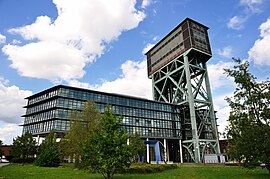Mine Minister Stein
| Mine Minister Stein | |||
|---|---|---|---|
| General information about the mine | |||
| Hammerhead tower of the Minister Stein colliery | |||
| Information about the mining company | |||
| Operating company |
Gelsenkirchener Bergwerks-AG Dortmunder Bergbau AG Ruhrkohle AG |
||
| Start of operation | 1856 | ||
| End of operation | 1987 | ||
| Funded raw materials | |||
| Degradation of | Hard coal | ||
| Geographical location | |||
| Coordinates | 51 ° 32 '48 " N , 7 ° 27' 51" E | ||
|
|||
| Location | Eving | ||
| local community | Dortmund | ||
| Independent city ( NUTS3 ) | Dortmund | ||
| country | State of North Rhine-Westphalia | ||
| Country | Germany | ||
| District | Ruhr area | ||
The Minister Stein colliery was a coal - mine in Dortmund district Eving .
history
The colliery was founded in 1856 by the investors Theodor Sprenger , businessman in Essen , and Heinrich Grimberg , innkeeper in Bochum . It has been named after the Prussian minister and important reformer Karl Freiherr vom Stein since April 4, 1871.
After the completion of a Malakow tower and the other daytime facilities , an annual production of over 100,000 tons was achieved as early as 1878. In the start-up crisis of 1873/1874, a consortium led by Friedrich Grillo , who was also the owner of the neighboring Fürst Hardenberg colliery , acquired the mine. Both collieries merged to form Vereinigte Stein & Hardenberg and the new owner was Gelsenkirchener Bergwerks-AG .
Between 1923 and 1926, Minister Stein was expanded into a large shaft system with now four shafts. In 1926 a hammer head winding tower was erected over shaft 4 . It was the first steel headframe in Germany designed for two equal grants .
On February 11, 1925, 136 miners were killed in a firedamp explosion , 8 workers survived the accident. In 1927, a memorial designed by the Dortmund sculptor Friedrich Bagdons was erected in the north cemetery to commemorate the crashed miners .
In 1929 the mine achieved its highest output to date with over 1.6 million tonnes a year. After the opening of shaft 6 in 1941, Minister Stein rose to become the largest colliery in the Ruhr area with a production of 3.67 million tons and 6820 employees . During the Second World War , the mine was badly damaged by several bomb attacks. In 1945 the mines Minister Stein and Prince Hardenberg were separated. Production at Minister Stein could only be resumed in autumn 1946. After the liquidation of Gelsenkirchener Bergwerks-AG , the colliery came to the newly founded Dortmunder Bergbau AG in 1953 , which later became part of Ruhrkohle AG .
In 1958, shaft 7 was put into operation, which had a final depth of 730 meters. A year later, the Fürst Hardenberg colliery was connected. The production rates in the post-war years were between 2 and 2.7 million t / year. During the nationwide wave of wildcat strikes in September 1969, Minister Stein and Prince Hardenberg were the first striking mines in the Ruhr mining industry.
At the end of the 1960s and the beginning of the 1970s, radical left-wing groups tried to tie in with the communist traditions of the Weimar period, both of which were partly violent agitation against the Ruhrkohle AG, into which the colliery was incorporated, and which more or less carried out in it the coal and steel co-determination integrated industrial union mining and energy, as well as ignite against each other. Some of the disputes are documented online in detail.
For a long time, the pits were only indirectly affected by the collapse of the Ruhr area, as relocated miners were taken in. The last coal was mined on Minister Stein in 1987, then the mine was closed. Minister Stein was thus the last sponsoring Dortmund mine. On the former site of the traditional coal mine in the heart of Eving today brings to mind the totally renovated Hammerkopfturm as a landmark of the New Center Evings to their long history. It is registered as an architectural monument in the list of monuments of the city of Dortmund .
photos
1974: Federal Chancellor Willy Brandt underground on Minister Stein
literature
- Wilhelm Hermann, Gertrude Hermann: The old mines on the Ruhr. 6th edition. updated by Christiane Syré and Hans-Curt Köster. Langewiesche successor Hans Köster, Königstein im Taunus 2007, ISBN 978-3-7845-6994-9 .
Individual evidence
- ^ Colliery Minister Stein in the MAO project
- ↑ List of monuments of the city of Dortmund. (PDF) (No longer available online.) In: dortmund.de - Das Dortmunder Stadtportal. Monument Authority of the City of Dortmund, April 14, 2014, archived from the original on September 15, 2014 ; Retrieved June 13, 2014 (size: 180 KB). Info: The archive link was inserted automatically and has not yet been checked. Please check the original and archive link according to the instructions and then remove this notice.
Web links
- Description of this sight on the route of industrial culture
- http://ruhrzechenaus.de/dortmund/do-minister-stein.html










